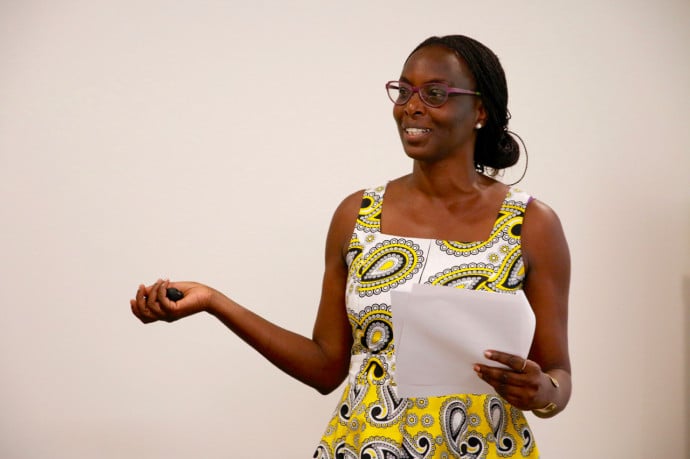“It’s like testing fate while standing naked,” said Yvonne Adhiambo Owuor, STIAS artist-in-residence, who presented a fascinating insight into her creative process at a recent STIAS fellows’ seminar.

Describing some of the “vulnerability, creative discomfort and alchemy” that accompany the process of entering the world of a story, Owuor pointed out that: “There are no roadmaps, no certainties, no formula. You hope and trust in the process and that it will one day deliver on its promise.”
Yvonne Adhiambo Owuor is a Kenyan writer, who won the 2003 Caine Prize for African Writing for Weight of Whispers and the 2015 Jomo Kenyatta Prize for Literature for Dust. She is currently in residence at STIAS while working on her next novel provisionally titled Tizita which she describes as “a coming-of age Africa journey tale told through the lives of seven Nairobi multicultural, multinational, Motocross-competing youthful misfits, who are in pursuit of a haunting honey-guide while biking through Eastern Africa.”
“Through this lens it invites its protagonists (and its author and future readers) to look again at some of the outer and inner landscapes (what is, what is devastated, what is emerging) that inform their Africa legacy and belonging especially as ‘in-between’ citizens of an ‘in-between’ nation,” she continued. “The young people are invited into questions that might allow them to call into being a future forged out of their seeing and their yearnings.”
Tizita is an Amharic word for ‘nostalgia’ and Owuor will dip into the scholarship of nostalgia, longing and memory. Describing herself as a “professional procrastinator” and her process as “I write when I find a place of stillness”, Owuor indicated that some of the ideas for the novel had developed on a recent train ride from Stellenbosch to Cape Town.
“All procedures are personal and different,” she said. “Some call for strange interventions.”
Owuor hopes the novel will offer an opportunity to reflect on current African youth in a way they haven’t been seen before. “There is a rather presumptive and also simplistic notion and construction of ‘African youth’ that is simplistic, and does nothing to suggest their complicated dimensionalities and ways of engaging their continent and world. This story is, perhaps, an invitation to look and listen again.”
“I refuse to be part of those who presume to know,” she added.
“They have been presented as the ‘African demographic bulge’ – an immense density of one age group in one space – which, depending on perspective, is either seen as a demographic dividend or disaster”, she said. “I am working with the protagonists in the story as a means to complicate prevailing and presumed notions of Africaneity.”
“Their ways of being and choosing are rarely documented in present conversations about African futures. I’ve met them and I am in awe of them,” she continued. “Most hold gargantuan dreams, are self-driven. They imagine this continent so differently. They are contemptuous of the elders who have mortgaged their lives. They intend to remake the world in their image and likeness. They are fearless in the face of life’s vagaries.”
“They are in-between people who straddle worlds and sometimes fall into strange dimensions,” she said. “I’m eager to learn their story and what they long for.”
“I see my young protagonist as a boy-man; a dark, helmeted teen who stands on the cusp of adulthood, whose body is still innocent and unworn. He sees adventuring as a way to escape the limits of the imagination. He yearns for the unknown.”
“I’m trusting that I shall come to know how to listen to what he is thinking and imagining,” she continued.
Owuor hopes that her novel will at least partially attempt to answer some complex questions including: Where is the ‘locus of meaning’ in Africa’s imagined geographies?; What do these say about a possible other future?; and, How can an exorcism of Africa’s persistent demons be imagined?
“I’m also inspired by the post-modern season of flux in the world,” she added.
While admitting that the process of writing a novel is “tainted, fed and obscured by quotidian happenings, historical moments and current trends”, she hopes that Tizita will emerge as one of many “narrative cartographies of an imagined and timeless African future which explores questions of how the journey to that future-as-destination begins”.
“It is a story from Africa, located in Africa, but if it is well realised it will find global resonance,” she said.
But the story creation work starts here at STIAS. “The job of reeling in the ‘creature’ is mine alone,” she added.
Words: Michelle Galloway, Part-time media officer at STIAS
Photograph: Christoff Pauw
